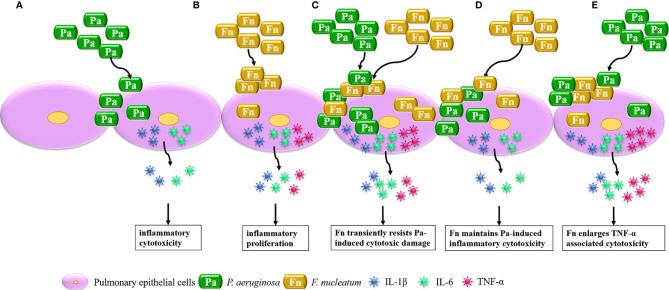Figure 7.
Schematic diagram of the effect of mixed infection with P. aeruginosa and F. nucleatum on pulmonary epithelial cells based on the present model. (A) When pulmonary epithelial cells are infected with P. aeruginosa alone, P. aeruginosa induces IL-1β and IL-6 associated inflammatory cytotoxicity of pulmonary epithelial cells. (B) When pulmonary epithelial cells are infected with F. nucleatum alone, F. nucleatum initiates high inflammatory proliferation of pulmonary epithelial cells. (C) When pulmonary epithelial cells are simultaneously infected with P. aeruginosa and F. nucleatum, F. nucleatum coaggregates with P. aeruginosa to synergistically invade into pulmonary epithelial cells and transiently resists P. aeruginosa-induced cytotoxic damage to induce over-release of IL-6 and TNF-α. (D) When pulmonary epithelial cells are pretreated with P. aeruginosa, F. nucleatum subsequential infection maintains P. aeruginosa-induced inflammatory cytotoxicity. (E) When pulmonary epithelial cells are pretreated with F. nucleatum, F. nucleatum pretreatment enlarged TNF-α associated cytotoxicity of pulmonary epithelial cells subsequentially infected with P. aeruginosa.

